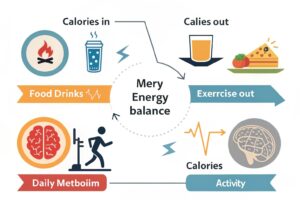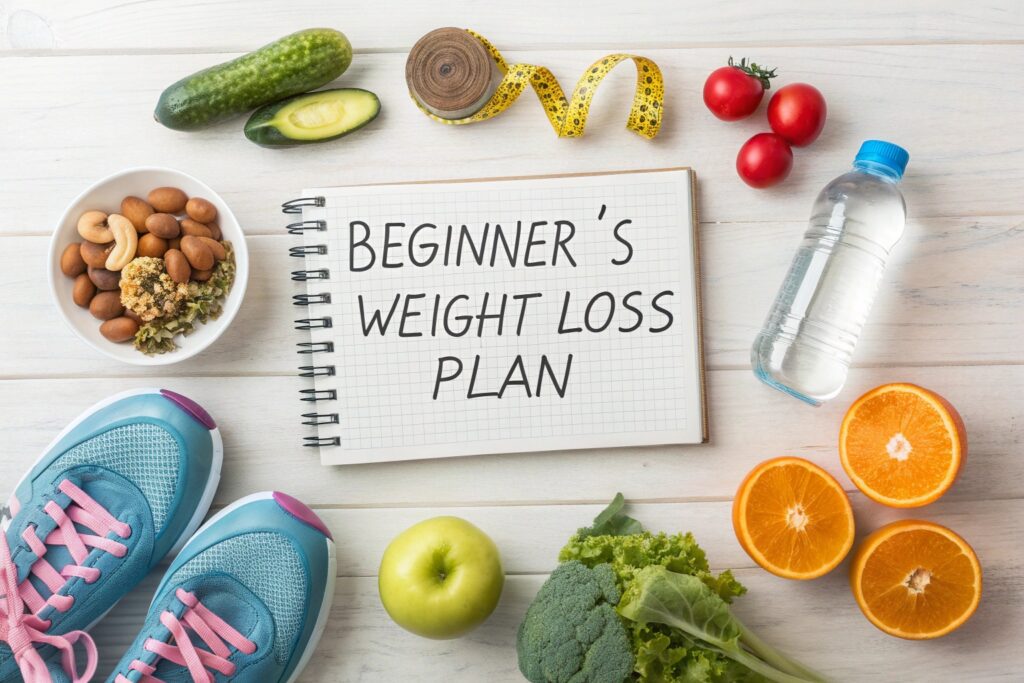Introduction
The Ultimate Beginner’s Guide to Sustainable Weight Loss
Losing weight can feel like navigating a maze of diets, gadgets, and conflicting advice. If you’re new to the journey, you deserve a clear, science‑backed roadmap that prioritises health over quick fixes. This article is The Ultimate Beginner’s Guide to Sustainable Weight Loss—a step‑by‑step reference that blends nutritional fundamentals, behavior change techniques, and realistic goal‑setting. By the end you’ll understand why crash diets fail, how to create a lasting calorie deficit without feeling deprived, and which tools support steady progress. Let’s turn confusion into confidence so you can achieve lasting results that feel effortless and enjoyable.
Why “Sustainable” Beats “Rapid”
Sustainable weight loss focuses on long‑term lifestyle adjustments rather than short‑term restriction. Research from the National Weight Control Registry shows that 96 % of successful maintainers cite consistent habits—like regular physical activity and balanced eating—over extreme diets (Wing & Phelan, 2022). A sustainable approach respects your body’s metabolic rhythm, preserves muscle mass, and reduces the risk of rebound weight gain. Moreover, it aligns with mental‑health best practices: healthier food choices and regular movement improve mood, lower stress hormones, and boost self‑efficacy, creating a virtuous cycle that keeps you on track. By prioritising habit durability instead of rapid results, you protect both your waistline and your wellbeing.
The Core Pillars of Sustainable Weight Loss
Three pillars underpin every credible weight‑loss plan: nutrition, activity, and mindset. First, nutrition is not about counting every calorie but about choosing nutrient‑dense foods that keep you satiated while providing essential vitamins and minerals. Second, activity isn’t limited to the gym; it includes any movement that elevates heart rate—walking, gardening, or playful chores—making adherence easier. Third, mindset encompasses goal setting, self‑compassion, and tracking progress in a non‑judgmental way. When these pillars work together, you create an energy balance that supports gradual fat loss (generally 0.5–1 lb per week), the rate endorsed by the American College of Sports Medicine as both safe and effective.
Section 2: Understanding Energy Balance and Metabolism

What Is a Calorie Deficit, Really?
A calorie deficit occurs when you consume fewer kilocalories than your body expends for basal functions, digestion, and activity. However, the term “calorie” can be misleading; 100 calories from a piece of fruit come with fiber, vitamins, and water, while the same amount from sugary soda offers none of those benefits. A practical way to achieve a modest deficit—about 250–500 kcal per day—is to combine a slight reduction in portion sizes with an increase in daily steps or light resistance training. This method respects metabolic adaptation, minimizing the “starvation mode” response that can stall progress. According to a 2023 meta‑analysis in Obesity Reviews, a moderate deficit paired with protein‑rich meals preserves lean body mass better than aggressive cuts (Miller et al., 2023).
Metabolism: Myth vs. Reality
Many beginners assume a “slow metabolism” is the sole obstacle to weight loss, but metabolism is only one piece of the energy‑balance puzzle. Resting metabolic rate (RMR) varies by age, sex, muscle mass, and genetics, yet lifestyle choices can shift it by up to 10 % — especially through strength training that builds muscle, the most metabolically active tissue. For example, a 30‑year‑old woman who adds two 30‑minute resistance sessions per week can boost her RMR by roughly 50 kcal/day, according to research from the Journal of Applied Physiology (Peterson & Lanza, 2022). Understanding that you can influence metabolic rate empowers you to take concrete actions rather than blaming “innate” factors.
Section 3: Building a Nutritious Plate That Fuels Fat Loss
Prioritise Protein and Fiber for Satiety
Protein is the cornerstone of sustainable weight loss because it preserves muscle, supports thermogenesis, and curbs hunger. Aim for 1.2–1.6 g of protein per kilogram of body weight daily; a 70‑kg individual should target 84–112 g. Sources like legumes, lean poultry, Greek yogurt, and tofu provide high‑quality amino acids without excess saturated fat. Pair protein with fiber‑rich vegetables, whole grains, or fruits to slow gastric emptying and stabilize blood glucose, preventing the “energy crash” that triggers snacking. A trial published in Nutrition Journal found that participants who consumed ≥30 g protein and ≥25 g fiber at breakfast reported 30 % fewer mid‑morning cravings over eight weeks (Stanton et al., 2021).
Smart Carbohydrate Choices & Timing
Carbohydrates are not the enemy; the key lies in selecting complex, low‑glycemic options that release energy gradually. Sweet potatoes, quinoa, oats, and berries supply carbohydrates alongside micronutrients and antioxidants. Consider “carb‑cycling” — consuming higher‑carb meals around training sessions to replenish glycogen, while keeping rest‑day carbs modest. This strategy has been shown to improve body‑composition outcomes in athletes and recreational lifters alike (Wilson & Sharp, 2022). For beginners, a simple rule works: fill half your plate with non‑starchy vegetables, one quarter with lean protein, and the remaining quarter with whole‑grain carbs.
Hydration and Micronutrient Balance
Water often flies under the radar in weight‑loss discussions, yet even mild dehydration (as little as 2 % body‑water loss) can impair metabolic rate and increase perceived hunger. Aim for 2–3 L of fluid daily, choosing water, herbal teas, or infused sparkling water over sugary drinks. Additionally, ensure adequate intake of micronutrients that influence metabolism, such as iron, magnesium, and B‑vitamins. A deficiency in magnesium, for instance, can hinder insulin sensitivity and increase fatigue, making exercise feel harder. A quick blood‑test or a home‑testing kit can identify gaps, allowing targeted supplementation under professional guidance.
Section 4: Movement Strategies That Stick
Find the “Exercise You Enjoy” Formula
Adherence is the most potent predictor of long‑term weight loss success. A 2020 study in Preventive Medicine reported that participants who chose activities they found enjoyable were 2.5 times more likely to maintain a routine after 12 months than those who followed a prescriptive program (Kwan & Smith, 2020). Mix aerobic work (brisk walking, cycling, swimming) with resistance training to maximize calorie burn and muscle preservation. Start with 150 minutes of moderate cardio per week and two strength sessions targeting major muscle groups; this aligns with CDC recommendations and balances cardiovascular health with metabolic benefits.
Incremental Progression: The 10‑Percent Rule
To avoid plateau and injury, increase training load by no more than 10 % per week—a principle rooted in progressive overload science. If you’re comfortable jogging 3 miles at a steady pace, add 0.3 miles or a few extra minutes the following week. This gradual increase challenges the body just enough to stimulate adaptation without overwhelming recovery systems. For strength work, add 2–5 lb to each lift weekly, focusing on form and controlled tempo. Tracking these increments in a workout log or app helps you visualize progress and stay motivated.
Integrating Activity Into Daily Life
Not everyone has time for structured workouts, but the total daily energy expenditure (TDEE) includes non‑exercise activity thermogenesis (NEAT). Simple habits—standing while on phone calls, parking farther from entrances, taking stairs, or doing household chores—can add up to 200–400 extra calories burned per day. A landmark study by Levine et al. (2005) showed that increasing NEAT by 350 kcal/day contributed to significant weight loss over six months. Set a daily step goal (e.g., 10,000 steps) and use a pedometer or smartphone to monitor progress. Small, consistent movements are the hidden engine of sustainable fat loss.
Section 5: Mindset Mastery & Behavior Change
SMART Goals: Blueprint for Success
Goal‑setting should follow the SMART framework—Specific, Measurable, Achievable, Relevant, Time‑bound. Instead of vague statements like “I want to lose weight,” craft a goal such as “I will reduce my waist circumference by 2 inches and lose 1 lb per week for the next 12 weeks by tracking meals and exercising four times weekly.” This clarity improves accountability and enables precise tracking. Review and adjust goals every month based on data from your food diary, scale, or body‑fat measurements, ensuring they remain realistic and motivating.
Cognitive‑Behavioural Techniques for Craving Control
Cravings often stem from emotional triggers rather than true physiological hunger. Cognitive‑behavioural strategies—like “pause, plan, proceed”—instruct you to pause when a craving hits, plan a healthier alternative, then proceed with the chosen action. Journaling emotions before meals can reveal patterns (e.g., stress‑eating after work). A 2019 randomized trial in Behaviour Research and Therapy found that participants who applied CBT‑based craving management lost 4 % more body weight over six months compared with control groups (Hofmann et al., 2019). Practising mindfulness meditation for 5–10 minutes daily further enhances impulse control and reduces stress‑related eating.
Social Support and Community Accountability
Weight loss is not a solitary venture; community influence dramatically shapes outcomes. Studies highlight that individuals with a supportive network—whether family, friends, or online groups—are 70 % more likely to reach their targets (Burke et al., 2018). Join a local walking club, participate in a virtual challenge on platforms like MyFitnessPal, or enlist an “accountability buddy” who shares weekly check‑ins. Publicly committing to a goal—through a social media post or a group pledge— adds a layer of external accountability that can keep you moving forward when internal motivation wanes.
Section 6: Practical Tools, Tracking, and a Step‑by‑Step Launch Plan
Choose the Right Tracking App for Your Lifestyle
Technology simplifies the monitoring of calories, macros, and activity. Popular options include MyFitnessPal for food logging, Cronometer for micronutrient detail, and Strong for strength‑training logs. Look for apps that sync with wearables (Fitbit, Apple Watch) to auto‑record steps, heart rate, and sleep—variables that influence weight‑loss efficacy. Consistency matters more than the tool itself; aim to log meals within 30 minutes of eating to capture accurate data and identify patterns early.
Weekly Step‑by‑Step Blueprint (First 4 Weeks)
Week 1 – Baseline & Planning
-
- Record current food intake for three days using a tracking app.
-
- Measure weight, waist, and body‑fat percentage (if possible).
-
- Set SMART goals and write them down.
Week 2 – Small Calorie Deficit & Movement Initiation
-
- Reduce daily calories by 200–300 kcal via portion control (e.g., swap a sugary drink for water).
-
- Add 10 minutes of brisk walking three times this week.
Week 3 – Protein & Strength Integration
Increase protein to ≥1.2 g/kg by adding a lean source to each meal.
-
- Begin two 20‑minute bodyweight strength sessions (squats, push‑ups, rows).
Week 4 – Review & Adjust
-
- Compare weight and measurement changes; adjust calorie target if weight loss <0.5 lb/week.
-
- Introduce one new habit (e.g., meal prepping on Sundays).
Continuously repeat this cycle, building intensity gradually while maintaining a balanced diet and mindset practices.
Long‑Term Maintenance & Scaling Up
After the initial 12‑week phase, transition to a maintenance calorie level (typically 100–150 kcal above your weight‑loss intake) while preserving the habits you’ve built. Re‑evaluate goals every three months—perhaps shifting focus to strength gains, improving sleep quality, or mastering a new sport. Keep using tracking tools for periodic audits, but allow flexibility to avoid burnout. Remember, sustainable weight loss is a lifelong journey, not a destination; the expertise you’ve gained now becomes the foundation for ongoing health, confidence, and vitality.
Conclusion & Call to Action
Congratulations! You now possess The Ultimate Beginner’s Guide to Sustainable Weight Loss, equipped with evidence‑based nutrition strategies, movement plans, and mindset tools that empower lasting change. Take the first step today: log your current meals, set a SMART goal, and schedule a 20‑minute walk tomorrow morning. Share your progress in the comments below or on social media using #SustainableWeightLossJourney—your story could inspire others and create a supportive community. For deeper dives, explore our related articles on “Mindful Eating Hacks” and “Building a Home Gym on a Budget.” Remember, every small, consistent action compounds into the healthy, vibrant life you deserve. Let’s make it happen together!



